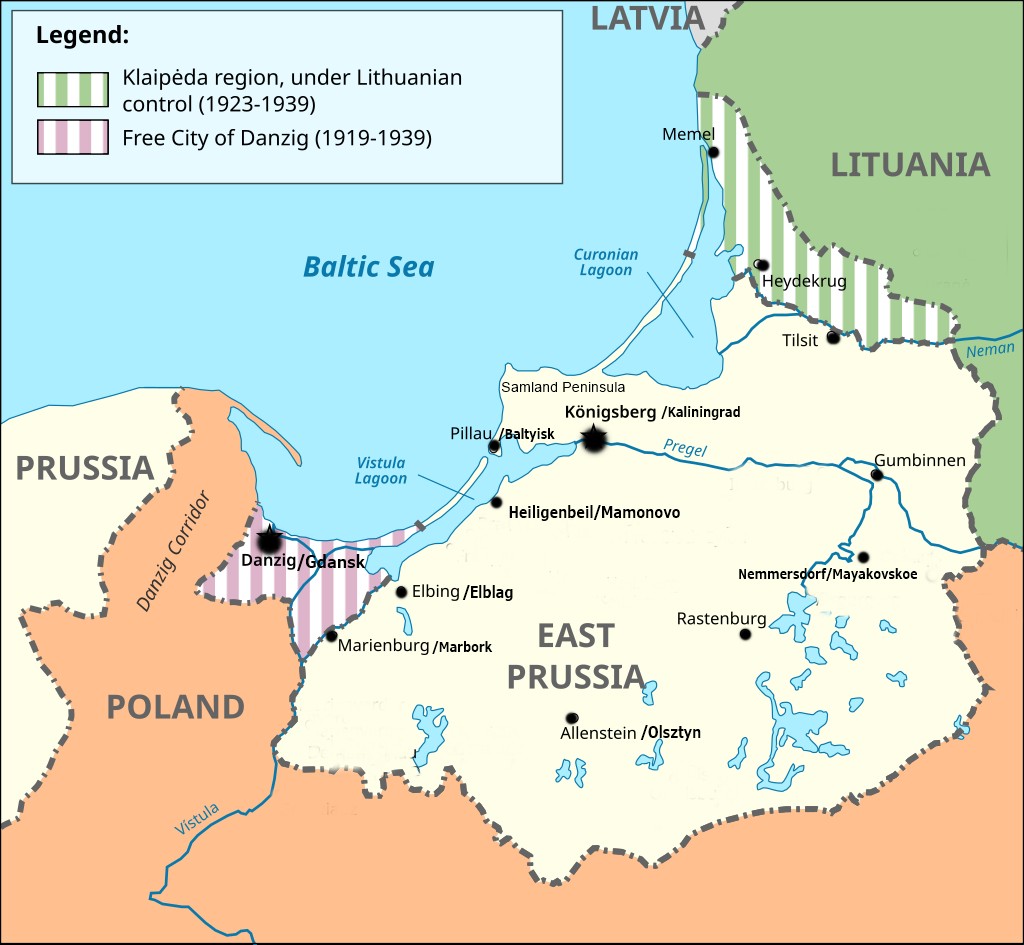The latest in our occasional series of articles by ANDY FORD on 80-year anniversaries of events in WW2 in the Soviet Union and Eastern Europe
*******
By early February 1945, the position of the German Army on the Baltic was a monument to Hitler’s stupidity and strategic ineptitude. 200,000 German troops remained marooned in Courland, north-west Latvia, 30,000 German soldiers were encircled in Poznan/Posen in Pomerania. Konigsberg (now Kaliningrad, Russia) was cut off with another 200,000 soldiers, and Danzig (now Gdansk, Poland) was about to be surrounded.
Hitler’s ‘stand and fight’ orders condemned thousands of German troops to a pointless death or Stalinist captivity. “Where the German soldier has stood he will never retreat” was his pompous declaration, even as he himself moved his HQ from the ‘Wolf’s Lair’ in Rastenburg, East Prussia, to the ‘Eagle’s Eyrie’ 500 miles to the west.
Military developments
The Russian assault on East Prussia began in January but they at first made slow progress, as the whole province had been fortified in depth against attack from the east.
Marshal Rokossovsky, attacking from the south, had already reached the Vistula Lagoon west of Konigsberg on 24th January leaving the only route from Konigsberg to Germany either by sea or along a single road on the sandbars of the Baltic coast. Then, in late February, after the collapse of the German armies in Poland [LINK], the Red Army in Poland was ordered to turn north towards the Baltic instead of pressing on to Berlin.
The Germans were caught by surprise and on 27th February, the Soviets captured Neustettin/Szczecinek in Pomerania, and then, on 2nd March they reached Koslin/Koszalin, 120 miles west of Danzig and only 12 miles south of the Baltic Sea. This cut off Danzig, the original territory for which Hitler had ostensibly gone to war, from the rest of Germany. On 10th March Zhukov occupied the coastal town of Elbing/Eblag on the Baltic coast, so separating Danzig from Konigsberg.
The German armies were now cut off in two pockets centred on Danzig and Konigsberg – and the remaining German armies in East Prussia gradually fell back to the provincial capital, Konigsberg, accompanied by hundreds of thousands of terrified civilians.
Millions of civilians begin to flee
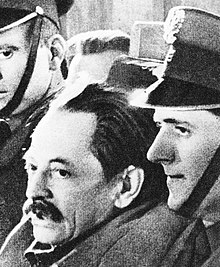
The German population had been told, firstly, that they were going to win the war in a year; then that it would take longer; and then that an army had been lost at Stalingrad but that there was a sure defence on the River Dnieper, far to the east; and finally, that the Russians were at the frontiers – but that the German homelands would be defended. The Nazi Gauleiter of East Prussia, Erich Koch, refused to plan for the evacuation of civilians as it “would lower morale”. Now, when the Red Army were fighting their way into East Prussia, he, who had told the soldiers to stand and fight, to “die for Germany,” promptly fled to the safety of Berlin.
The situation for the East Prussian civilians was horrendous. The young men were in the army fighting all over Europe, and older men had been conscripted into the Volksturm, a sort of Nazi home guard. The elderly, women and children now found themselves facing vengeance from the Red Army for all the Nazi crimes in the Soviet Union, crimes which they had not committed. They also faced abandonment by the ‘true German patriots’ of the Nazi Party.
A soldier from the Gross Deutschland SS Division described their plight:
“We passed through towns and villages where the inhabitants had still been living a more or less normal life until four or five days earlier, although they had realized that their danger might become imminent at any time. Now, for the last two days, old men, women, and children had been desperately digging out the trenches, gun pits, and anti-tank ditches which were to stop the waves of enemy tanks. This pathetic and heroic effort before the infernal debacle which would sweep them into the flux of terrorized civilians was a preliminary shock for these virtuous civilians, who saw the front coming toward them in the form of exhausted, half-starved troops, tired of fighting and of living, who brushed aside human pawns without a qualm, as if they were pieces in a losing game of chess.
Everything which still possessed a shred of human or mechanical life was moving, suppressing misery to a sense of gratitude that so much, at least, was still allowed them. Bombings stopped only those who were definitively dead. The rest—the merely wounded or dying—kept on, with burning eyes, pushing past the collapsing and the collapsed, whose bodies lay strewn along the road.”
(Guy Sajer, ‘Blood Red Snow’)
Given what transpired later, the fear of East Prussian civilians was totally justified, but it had been intensified by Nazi propaganda. In autumn 1944 Russian troops had occupied some villages on the Prussian frontier. When the Wehrmacht retook the villages, including one named Nemmersdorf, they found a horrifying scene. Dozens of women, children and old people had been murdered, buildings torched and women assaulted and raped.
After initially hesitating between denying that the Russians were on German soil, or using the massacre to stiffen German resistance using simple fear and terror, Goebbels’ propaganda ministry opted for the latter, embellishing the facts of what had happened with sickening details more suited to a horror film, and showing the resulting newsreel all over Germany.
What had happened in Nemmersdorf was no more than what had happened in literally thousands of Soviet villages and towns, but that did not make it right, and was in no way how a “socialist army” would have conducted itself.
Destruction, looting, murder and rape: The Red Army in East Prussia
Unfortunately, as the Red Army drove into East Prussia in 1945, the same pattern was repeated over and over. The least that German civilians could expect was to be robbed and their homes looted. There were cases of Russian troops machine-gunning refugee columns or driving their tanks through them. Looting was encouraged by Stalin’s order that each soldier could send home a 5kg package, which was treated as a right to compensation for the losses many Russian families had endured. Officers could send home twice as much.
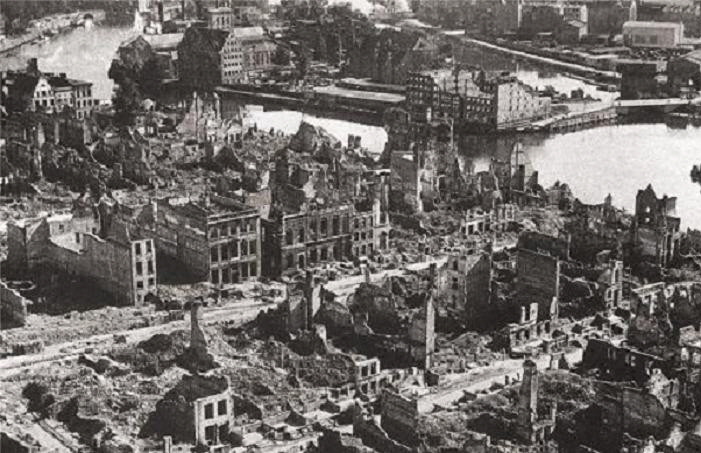
Soldiers entered houses and smashed all the furniture they found there; they even torched houses that could have sheltered them for the night. The British journalist, Alexander Werth [Russia in the War], recounted the anger and bewilderment of the local Polish population at the burning down of the mixed German/Polish town of Allenstein/ Olsztyn which had been captured almost intact.
The most likely explanation of the disappearance of Catherine the Great’s fabled ‘Amber Room’ is that it was destroyed when drunken Soviet officers set fire to Konigsberg Castle after a huge post-victory drinking bout. The Amber Room was a marvel of craftsmanship, with all the panelling constructed from Baltic amber. It was looted from Russia by the Nazis and taken to Konigsberg where it was displayed as a war trophy. After RAF bombing raids it was crated up and placed in the basement of Konigsberg Castle, but when the city fell to the Red Army, the crates disappeared without trace in 1945. When the room was recreated in the 1990s it cost $3.5 million and took 24 years.
The worst behaviour was the mass rape of German women and girls, often with extreme violence. There were 4,000 prosecutions for rape but thousands more went unpunished. Even Russian and Byelorussian women were raped by Russian soldiers, as recounted by Vasily Grossman:
“Liberated Soviet girls quite often complain that our soldiers rape them”. He noted the “Horror in the eyes of German women and girls…terrible things are happening to German women…A cultivated German man explains to us that his wife has been raped by ten men that day”.
(Quoted in ‘Berlin’ by Antony Beevor)
The senseless consumption of alcohol by the second echelon troops who followed the front was a major factor in their rampages, even affecting the fighting capacity of the soldiers. An NKVD report back to Moscow said that, “Mass poisoning from captured alcohol is taking place in occupied German territory” and witnesses saw Russian soldiers drinking raw alcohol from laboratories and workshops [Berlin – Antony Beevor]
Some Russian soldiers and officers did try to prevent such behaviour, or at least refused to take part. Marshal Rokossovsky issued an order instructing his soldiers to direct “feelings of hatred at fighting the enemy on the battlefield”, and stating that “looting, violence, robbery, unnecessary arson and destruction” would be punished, but still it went on [Berlin – Antony Beevor].
But there was almost no punishment for those who did, and those who took their opposition beyond a certain level could even be arrested. Lev Kopelev, later a Soviet dissident, was arrested and imprisoned for expressing sympathy for German civilians, a ‘crime’ termed ‘bourgeois humanism’. Solzhenitsyn, then a Red Army artillery officer, was arrested in February 1945 for his criticism of the conduct of the army in East Prussia, and later wrote his poem, ‘Prussian Nights’ protesting the gang rape of German and Polish women.
In the main, it was tolerated by senior Russian officers with a Russian major telling Alexander Werth that the women accepted their fate as “it was now the Russian’s turn”, and even making the sickening comment that:-
“Our fellows were so sex-starved that they often raped old women of sixty, or seventy or even eighty—much to these grandmothers’ surprise, if not downright delight. But I admit it was a nasty business, and the record of the Kazakhs and other Asiatic troops was particularly bad.”
[Russia in the War – Alexander Werth]
Stalinists incite racial hatred
How could such things happen? The explanation lies in the promotion by Stalin and his propagandists of a crude racial hatred of all Germans. According to them, the German people bore collective responsibility for the crimes of the Hitler regime. This, of course, excused Stalin for his role, firstly in enabling Hitler’s seizure of power, and secondly leaving the Soviet Union so tragically unprepared for Hitler’s betrayal of the Molotov-Ribbentrop Pact in the 1941 invasion.
As the Russian soldiers crossed the frontier into East Prussia, they would see posters saying, “Red Army Soldier: You are now on German soil; the hour of revenge has struck!” or even, “Here it is, the accursed Germany”.
But as The British Trotskyist, Ted Grant, wrote in Socialism and German rearmament in 1954:-
“The idea sedulously disseminated during and after the war that the German people, and above all the German working class, are naturally militarist, does not bear examination. No more than the workers in Britain are the workers in Germany supporters of militarism and of war. The idea that the German workers were supporters of Hitler is a travesty of actual developments in Germany.
The responsibility for the victory of Hitler and all its tragic consequences for the workers of Germany and the world was directly that of the leadership of the trade unions and Social Democratic Party, and of the so-called Communist Party in Germany.”
The Russian journalist, Ilya Ehrenburg, made it his speciality to incite hatred against Germans as a ‘race’ and especially German women, as in Soviet War News of December 1944:
“Let the defenders of the “poor Germans” sing like nightingales if they wish, but we, who have heard the last death cries of little children, are not be charmed by the roulades of the contemptible advocates of the murderers.
“The Germans …have defiled all Europe. It is futile … to assert that we are going to Germany after German females. We are not drawn by their Gretchen’s, but by those Fritzes who insulted our women, and we say plainly that we will have no mercy on those Germans. As for German women, they evoke in us only one feeling – of disgust. We despise them because they are the mothers, wives and sisters of hangmen. We despise them because they wrote to their sons, husbands, brothers “Do send us a pretty fur coat!” We despise them because they are thieves and decoys. We need none of these flaxen haired hyenas. We are going to Germany for something different – for Germany. And that particular flaxen-haired witch will not get off easily.”
The Trotskyists of the time opposed such a blatantly chauvinist policy and exposed Ehrenburg as a former white guard i.e. armed opponent of the 1917 Russian Revolution, and proponent of race hatred:
“Flee, you Germans. Retribution has come. We will forget nothing. The soldiers now storming German cities will not forget how the mothers of Leningrad dragged their dead children along on sledges. Berlin will pay for everything. Berlin is round the corner and nothing can stop us… You know that we have before us millions of creatures perverted by plunder and treachery, cruelty and arrogance. We want to save the world from the club law of these millions. We will deal with the criminals convicted of atrocities. The others – their abettors, confederates and accomplices we shall force to work. They shall no longer manufacture any V1s or V 101s. They shall plant potatoes and tend pigs.”
(Ilya Ehrenburg, Red Star 31st of January 1945)
The British socialist newspaper, Socialist Appeal pointed out that:
“If the Red Army was operating the policy of Lenin and Trotsky the entry of the Red Army to Germany would be a signal for socialist revolution throughout Europe. If Stalin carried a message of a socialist Soviet Germany united to Soviet Russia, the German masses would have overthrown Hitler and set up Soviet Germany. They would have welcomed the Red Army as an army of liberation from fascism and capitalism. What the position might have been was seen by many instances which have taken place during the war. The German soldiers had to be threatened with punishment and death in a special order by the German general staff for feeding Ukrainian women and children from the field kitchens.”
(Socialist Appeal, February 1945)
But alarm was growing in the Soviet High Command at the situation – the troops were getting out of control, getting drunk and defying their officers, or even shooting officers who tried to stop the rape and destruction. On April 14th Ehrenburg was publicly rebuked for his ‘mistakes’ on the direct orders of Stalin, who had begun to realise that he would need some Germans to work with after the war.
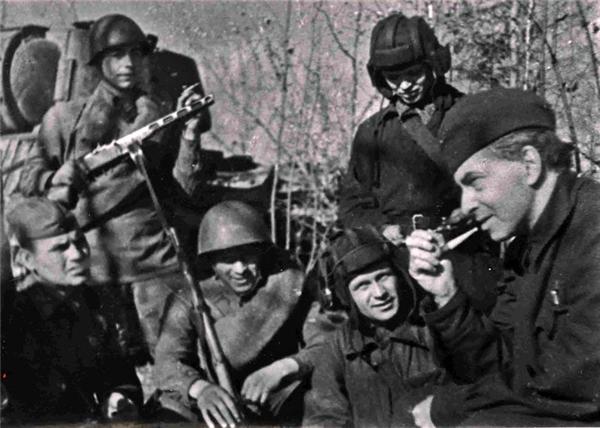
Propagandist, with Red Army troops
The article “Comrade Ehrenburg is over-simplifying” tried to walk a tightrope of condemning Ehrenburg’s most extreme statements, whilst trying to gloss over the fact that this had been done at Stalin’s behest. The article made the obvious point that it was un-Marxist to condemn all Germans as monsters, quoting a moronic statement from Stalin in 1943, “Hitlers come and go, but the German people go on forever”, as if it was some sort of profound insight.
Stalin’s concern was not so much with atrocities against civilians as crimes against property. A previous article had said:
“Our revenge is not blind. Our anger is not irrational. In an excess of blind rage, one is apt to destroy a factory in conquered enemy territory – a factory that would be of value to us”.
(quoted in Alexander Werth, ‘Russia in the War’)
This would only have needed to be written if factories were, indeed, being pointlessly burned down.
Evacuation and tragedy for refugees in the Baltic
Millions of German civilians did not wait to find out what Stalin’s armies had in store for them. Of a pre-war German population of 2.3 million (there were also sizeable minorities of Poles and Lithuanians in East Prussia) almost 2 million fled either westwards, or north to the coast. Around half a million refugees were trapped in each of the besieged cities of Konigsberg and Danzig, where the German army fought ferociously to buy them time to be evacuated. This was achieved by the German navy in Operation Hannibal from January to April 1945, which evacuated refugees from the port of Pillau (now Baltiyisk, Russia) and from Danzig/Gdansk.
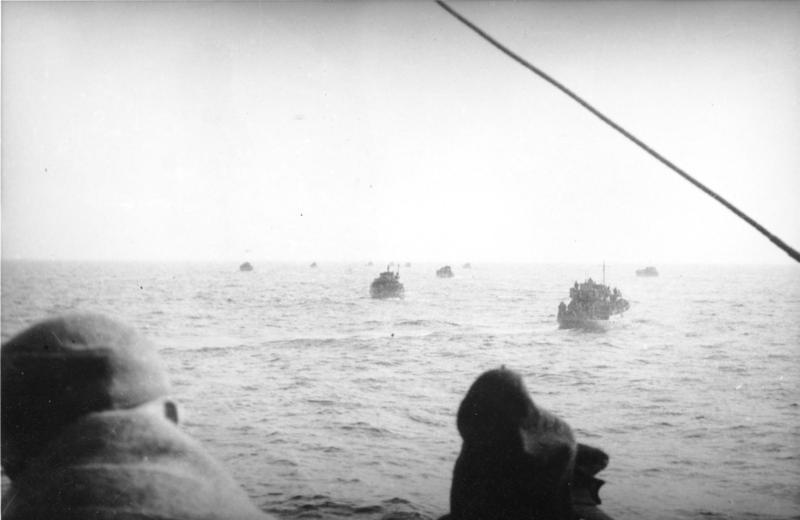
But this came at a terrible human cost in some of the worst maritime disasters in history. On 30th January the Wilhelm Gustloff was sunk by a Russian submarine with nearly 10,000 people on board, of whom 9,400 are estimated to have died in the freezing sea, and on 16th April, the MV Goya was torpedoed, and sank in minutes, with the loss of an estimated 7,000 lives. Over 150 ships laden with refugees and wounded were lost at sea. When the Russians moved into much of rural East Prussia all they found were ghost towns.
The end of East Prussia
The remaining German territory around Konigsberg was broken into three pockets in the course of March 1945. One of them, around the seaside town of Heiligenbeil (now Mamonovo, Russia) saw the German Fourth Army, around 150,000 men, trapped in the dunes along the Baltic coast, with a similar number of refugees. The refugees had to make a perilous journey across the ice either to Pillau or Danzig, hoping to be taken off by ship. The Fourth Army was eventually overwhelmed by 29th March, with 50,000 captured.
Konigsberg itself was defended fanatically by the Germans, even though their position was hopeless, to allow the civilians to be evacuated by hundreds of ships sent from Germany. It surrendered only on 9th April, after the garrison of 80,000 ran out of ammunition and food. In a grim replay of the siege of Leningrad, the civilian ration in the besieged city was reduced to 180g of bread a day.
The third fragment was around the port of Pillau on the Samland peninsula, north of Konigsberg. Pillau was the main embarkation point for Operation Hannibal, and it was defended almost to the last, only falling on April 29th with the loss of 80,000 men.
Each of these surrenders was a defeat on the scale of Stalingrad. Stalin’s stupid chauvinist policy ensured that the Germans fought to the last, with over 500,000 Soviet casualties resulting. If he had just followed the ‘rules of war’ like the western allies i.e. humane treatment of prisoners and military discipline for crimes against civilians that number could probably been halved.
Aftermath
With the fall of Danzig, Konigsberg and Pillau, East Prussia ceased to exist. Most of the German population had fled, and the 200,000 who remained were expelled in 1946 in line with the decisions of the Potsdam conference of the Allies. A whole way of life and culture was extinguished.
The north of the province became part of the USSR, as the Kaliningrad exclave, with every town given a new Russian name. Like a lot of ‘ethnically cleansed’ territories, it struggled to establish a viable economy. Masuria, which formed the southern part of the province, became a Polish province settled by Polish refugees from Byelorussia.

